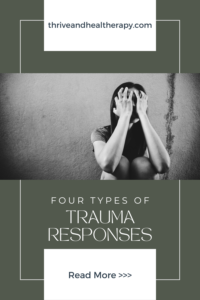Trauma can be defined as an emotional response to a significant event that causes a distressing experience. Trauma can present itself from emotional, neglect, and physical trauma as well as others. It is likely you have experienced trauma yet are unaware of it or maybe you are doing things a certain way due to previous trauma. Trauma can be complicated and difficult to understand. Understanding its different responses is a great way to start to understand what trauma consists of.
Getting into trauma talk can be hard. This can be a triggering topic itself and if you are feeling triggered. Going over different responses of trauma can be something you may relate to and maybe you will relate to as you come to find out perhaps how you respond to trauma.
Thinking of what your response is to trauma can help you to approach it in a way that you will be able to change it or deal with it in an effective way.
The impact of trauma can be different for each individual. To some, it may be subtle and to another it may be just the complete opposite. How the trauma affects each individual really depends on some few factors such as characteristics of the individual and the event.
How one may perceive trauma may not be how someone else perceives it even if they experienced the same exact thing. Therefore, each person’s response will vary according to how they deal with these things.
Responses to trauma varies. The trauma responses we will be talking about are fight, flight, freeze and fawn.
Fight
The flight response to trauma allows you to be able to navigate the situation by setting boundaries and really using assertive communication. Using the fight response in this way is considered to be healthy. However, on the other end, reacting with a negative emotion to stand up to the trauma can have a negative impact. With the fight response, you may experience negative emotions such as anger, irritability and aggression. These emotions are likely to have you move towards the situation and result to some unhealthy behaviors.
Flight
The flight response is when you would avoid the situation or run away from it. This may result to isolating yourself which can lead to being an unhealthy coping mechanism. When experiencing the flight response, it is important to check in with yourself and to notice more physical symptoms you are experiencing that may be resulting to you avoiding or running away from the situation. Those who utilize this response most likely feel that the situation they are in is a threat, therefore, finding coping techniques and being able to ground yourself will allow you to face the situation and be able to handle it in a healthy manner.
Freeze
The freeze response is really what you would imagine. Freeze. Slow down and wait to respond. With this trauma response, you may feel unable to move or may feel that you are not really there. It is like you are mentally not there or checked out. This is a form of safety for one who uses this response. This response may feel emotionally safe for many. In order to stay in the present, it can be helpful to practice some mindful exercises.
Fawn
The fawn response to trauma is a people-pleaser response. What that means is that if you were to experience the fawn response, this would look like putting your needs in the back while making other people needs above yours. This form of response is really about avoiding conflict and not making any waves. Therefore, you may have difficulty with saying no or setting boundaries. Here is a post about how to set healthy boundaries. This will help you to be able to set your priorities above others and be able to respond in a healthy manner.
Understanding your response to trauma can be the first step in identifying how you may need to heal. This also gives you insight on what could be a healthier way of responding. Therapy can be of help to learn these responses and what your type is so that you then learn to be mindful of it when it does occur and interrupt the pattern.










